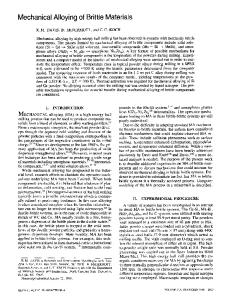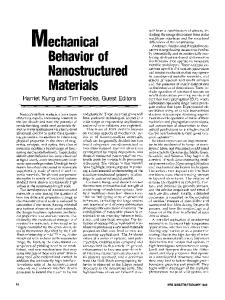Materials in Mechanical Design
- PDF / 5,871,034 Bytes
- 12 Pages / 576 x 777.6 pts Page_size
- 90 Downloads / 415 Views
following text is based on the Von Hippel address given at the 1992 MRS Fall Meeting in Boston, December 2.
10000 BC
5000 BC
DC O
a UJ >
LU
rx ENGINEERING CERAMICS JA^Oj. Si 3 N t , PS^etc ) 1000 1500
1600
DATE Figure 1. The evolution of the relative importance of different classes of materials from findings of archaeologists, educators, and prognosticators.
MRS BULLETIN/JULY 1993
The point of Figure 1, however, lies in its view of the future, drawn somewhat speculatively. Metals are continuing to advance, but at a slower rate. Rapid growth is in the fields of polymers and composites, of course—and, we think, in ceramics. The final distribution for 2020 is extracted from literature of various sorts. It is this distribution that automobile companies predicted a few years ago would form the basis of their automobiles in the year 2020, with metals constituting about a quarter of the car. Now the point of this picture is partly to demonstrate the evolution of materials, but also partly to emphasize the rate of development. Since my time scale is nonlinear, the slope in recent years is enormously steep. Materials are evolving faster today than at any other previous time in history. This evolution is driven, in part, as it has always been, by scientific curiosity; but it is driven also by a deliberate effort to meet human needs by engineering design. Figure 2 shows a simplified schematic of the design process and how materials enter into it. Initially, a market need is identified. Then concepts—physical principles—are derived that might fill that need. If the principle can be found, it is embodied and turned into a scheme involving the principle. If the embodiment looks practical, one moves to the detail stage of design, then engineering drawings, and finally to a product. One might think of the concept as pure physics, the embodiment as applied physics, and the detail as the engineering of the product, but the whole process is done by one person, the designer, who has to have a broad background. The designer draws on design tools involving, for example, modeling, optimization, and finite element techniques. These tools, in turn, are drawn from the disciplines of engineering science, e.g., mathematics, mechanics, thermodynamics, fluids, and so forth, as shown in Figure 2. I show this progression in order to calibrate it against the way in which materials information enters the design process, shown on the right side of Figure 2. There is a corresponding flow of information about the materials that enters the design process. The point is that at the conceptual stage the choice of materials is wide open, and all possibilities should be considered, though only at a low level of precision; you don't want to miss the one that is the ideal solution to your problem. At the embodiment stage, one needs information about a smaller subset of materials but at a higher level of precision. Finally, at the detail design stage, one needs information about perhaps one material at the highest possible level of precision. This info
Data Loading...











